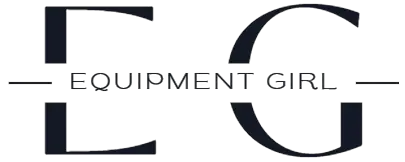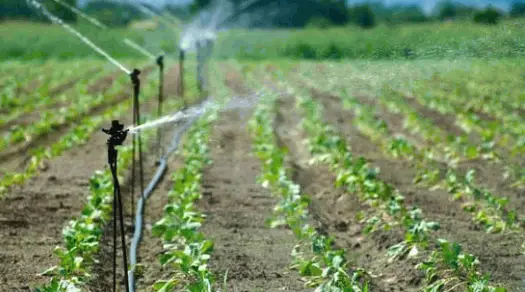Creating a truly beautiful garden relies on a few key elements and, arguably, the most important of these is watering. Plants rely on water for photosynthesis, which is how they create energy from sunlight. Without enough water, this process can’t happen and the plants won’t grow. So making sure that you choose the best watering system for your garden is an important decision for any avid gardener.
A soaker hose or drip irrigation system will both have benefits over a sprinkler-type system. This is because, rather than showering the plants with water from above, they deliver the water directly to the plant roots. This means that less water is lost from evaporation and it also helps to keep the foliage dry, which will lower the risk of fungal growth.
But which garden watering system should you choose? There are absolutely pros and cons to each, some of which will be important to different types of gardens and needs. So come with me as we go on a deep dive into the world of soaker hoses and drip irrigation systems so that you can find the ideal watering solution for you!
Check out: Gardening Tools For Bad Backs
What Is A Soaker Hose?
A soaker hose system is an elegant, simple, and efficient solution to keeping your plants watered. At first glance, it looks exactly like a standard garden hose but it has one key difference: pores that run the entire length of the hose. Soaker hoses are made of a highly porous material, usually a mix of recycled rubber and polyethene plastic.
These tiny holes allow water to seep out slowly and with very little water pressure, which means that the water can be delivered directly to the root zone of your plants where they will need it most.
Compared to a sprinkler irrigation system, soaker hoses are a more efficient solution that uses less water because less is wasted on parts of the plants that don’t need it, such as the foliage. The water seeps slowly into the soil itself rather than showering the plants from above. If you’re concerned about being as eco-friendly as possible, this makes it a good option.
Soaker hoses are also super easy to install. They are used in exactly the same way as a normal garden hose – by attaching them to your nearest faucet, such as your outdoor tap. Then you simply lay the hose where you would like the water to be delivered and turn the tap on. The water flow can be pretty slow because such little water pressure is needed.
It can be a good idea to cover the hose with mulch to prevent as much UV damage as possible. Too much time out in the sun can cause the rubber of the hose to crack.
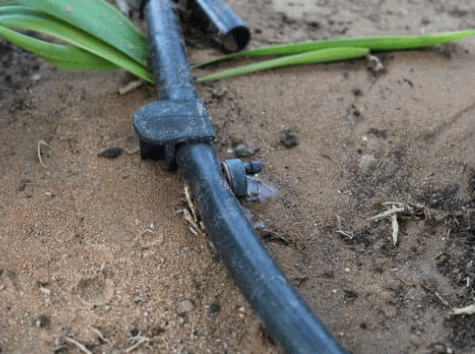
Benefits Of Soaker Hoses
- Cost-efficient – Installing a soaker hose requires very little upfront cost. All you need to do is buy the hose and attach it to a tap. This makes it a great option for someone just starting out or for someone with a smaller garden area.
- Time-efficient – Installing a soaker hose also requires very little upfront effort. If you don’t have a huge amount of time to spend creating a complicated irrigation system, then something simple like a soaker hose will do the job just fine.
- No need for a pressure regulator. It is easy to adjust the water pressure without the need for installing a pressure regulator. You just adjust how much water is coming through the tap. It’s as simple as that!
- Delivers steady water to your plants. Your plants will get a steady and even supply of water from a soaker hose.
- Unlikely to clog. A soaker hose is a reliable system that is highly unlikely to clog so you can expect it to do its job for a long period of time.
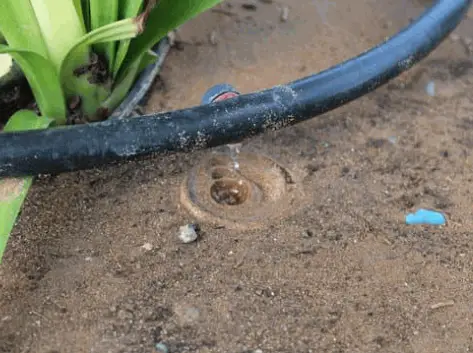
Limitations Of Soaker Hoses
- Not very versatile. If you have a more complicated garden set-up, a soaker hose may be difficult for you to use. It is difficult to configure it to deliver water to certain sections and not to others. Many gardeners end up needing to use several soaker hoses to deliver water to different sections which can become time-consuming and difficult to manage.
- Less precise watering. On a similar note, it is difficult to attempt precision watering when using a soaker hose. It delivers the water to the soil that surrounds it in a blanket fashion.
- Hard to repair. If a soaker hose gets damaged, it is difficult to complete section repairs and you may need to replace the entire length.
- Sometimes not suitable for food crops. Because some soaker hoses are made of recycled rubber, they may not be suitable for use to grow food crops.
- Limited in length. A soaker hose is reliant on the water pressure from the tap it is attached to so it has a definite length limit of usually around 200 feet. This makes them less useful for large gardens.
- Can’t be used on sloped grounds. Gravity will massively affect the flow of water through a soaker hose so they are best used on flat garden beds.
What Is A Drip Irrigation System?
A soaker hose is a type of low-tech drip irrigation system but when people talk about drip irrigation, they are usually referring to something a little more complex. These types of systems use mechanical means to deliver water to your plants’ roots.
Drip systems usually consist of a network of round tubing. There is a main water line to which is attached a series of smaller drip lines or drip tapes. These will have nozzles known as emitters attached to them along regular intervals that release water slowly.
There will also often be pressure regulators, pressure reducers, a filter, and a backflow valve and the system is usually made of polyethene plastic.
Drip irrigation is the type of watering system chosen by many professional gardeners and farmers because it allows for precision watering and is extremely water-efficient.
Check out: Arthritis Garden Tools
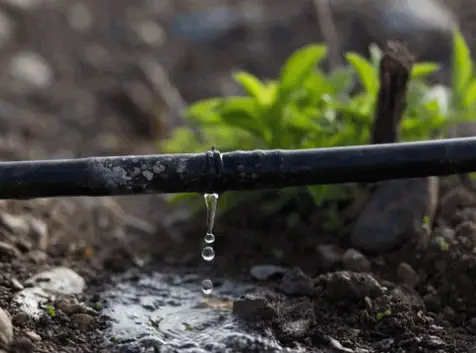
Drip Line Or Drip Tape?
Most people who use a drip system will opt for drip lines. Drip tape is essentially the same as a soaker hose but it lies flat until it is filled with water. These are subsurface installations and last around 1-5 years.
A drip line system, however, is installed above ground level and consists of solid plastic pipes that have emitters attached. Because they are made of strong plastic tubing and can last a lot longer than a drip tape system. This is the type of system most people are referring to when they talk about drip irrigation.
Benefits Of Drip Irrigation Systems
- Versatility. Perhaps the biggest benefit of drip irrigation is just how versatile it can be. You can configure the drip line’s drip emitters to seep water in some areas and not others, you can use timers to control the flow regulators for when the water is delivered, and the placement can be complex.
- Precision. Because you have so much control over drip line placement and water flow, you can precisely deliver the exact amount of water to specific plants. This makes it a great option for gardens with a wide variety of plant or crop types.
- Deep penetration. You can expect a deep soaking for your plants that covers a broad radius.
- Can be used on sloped ground. You can install pressure-compensating emitters in your drip line, which means they can be used on gardens that are sloped rather than just flat. If you have a garden that is landscaped with sloping, a drip irrigation system can be a great option.
- Good for raised beds. Because the flexible plastic tubing of the drip line can be off the ground, drip irrigation works well for raised beds as well as flat.
- Easy to repair. A drip irrigation system has a series of drip line sections, each of which has its own controlled water pressure. Because of this, damage to one section won’t affect the others so spot repair is a lot easier.
- Can be used for food crops. Because the drip line is made of polyethene plastic, drip irrigation systems can be used for vegetable patches.

Limitations Of Drip Irrigation Systems
- Can be costly. The upfront cost of drip systems is quite a bit higher than for something like soaker hoses. It is a much more complicated and highly engineered piece of equipment.
- Installing drip irrigation can be difficult. Some people opt to bring in professional installers for their drip irrigation system, which can raise the cost. You can install a drip irrigation system yourself, although it will take some time and effort to calibrate it properly.
- The emitters can become clogged. It is important to stay on top of maintenance with your drip line emitters because they can become clogged and the last thing you need is for a plant to unexpectedly not be watered.
- The drip line can be affected by the wind. Unlike a soaker hose where water seeps into the ground, drip lines drip water onto the garden beds. This can mean that in high winds, the water can get carried away from the area that you are aiming for.
Check out: Best Tool For Cutting Hedges
Drip Irrigation Vs Soaker Hoses
So which is the right system for you? Well that all depends on what you need your watering system to do, the type of garden you have, as well as other factors.
Soaker Hoses Are Perfect For:
- small gardens
- flat beds in straight rows
- gardens with plants that have similar water needs to each other
- gardeners that don’t want too much of an initial investment in their watering system
Drip Irrigation Systems Are Perfect For:
- large gardens
- sloped gardens
- gardens with a variety of different plants
- raised beds
- vegetable patches
The Bottom Line
Soaker hoses and drip irrigation are both excellent options for an eco-friendly watering system. They each will deliver water directly to the roots of your plants, reducing the amount of water that is wasted. Soaker hoses are a more simple, and less costly, solution that can be ideal for smaller gardens. Drip irrigation, on the other hand, will have a higher upfront cost but can be better for larger, more complex, gardens. Only you know which one will work best for your gardening needs but, whichever you choose, this type of water-efficient system can be the perfect addition to your garden installation. You won’t know how you ever managed without it!
